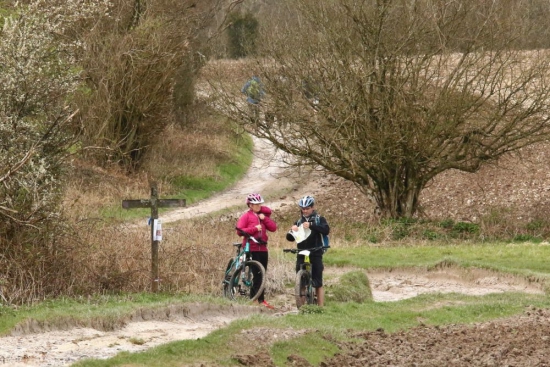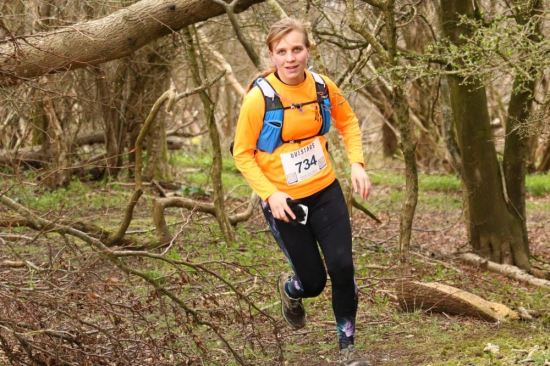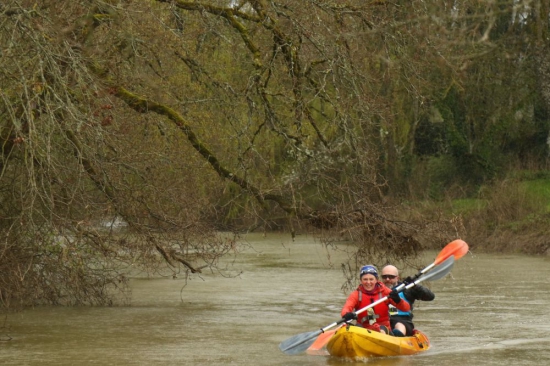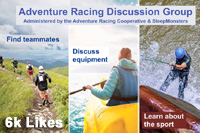Ups and Downs at the first ‘Summer’ Questars Race of 2024
Rob Howard / 28.03.2024


Questars returned to the chalk hills and heathlands, bridleways, woodlands and rivers of the South Downs for the first race of the Summer Series, though the weather in March made that a seasonally optimistic series title!
Racers arrived at Duncton Village Hall, near Petworth, under clear blue skies on a sparkling morning, though the wind still held a winter chill and the forecast promised some heavy showers later in the day. The bike transition was set up in the field in front of the hall, and the grass underfoot was very squelchy, so it was no surprise when Joe Selby asked in the briefing, “Who likes mud?” The bridleways were going to be muddy in places and the water level high on the kayaking stage on the Arun River, all adding to the fun!
The adventure racing arena for the day was a sizeable area of the South Downs National Park and racers could head in all directions from the start to find checkpoints. Most of the 20 run checkpoints (total value 360) were to the west and south, spread out along the wooded escarpment and taking in Graffham Down and Duncton Hanger.
The 20 biking checkpoints (total value 470) were mostly to the East and included one near the top of Duncton Down, which was a big climb with the reward of 35 points and some stunning views, at least early in the day. Later on it was an exposed spot to see the intense hail showers sweeping in towards you!

As this was the first Summer Series race kayaking was back for racers opting for the Trio race. (There is a Duo option without kayaking included as well, and run and bike only races, with time limits ranging from 2 to 6 hours, so there is something for everyone.)
The kayak stage had 6 checkpoints and teams were given an hour time slot during which they had to be on the water, with hefty penalties for going over their time. For this race the paddling was on the Arun River with the transition on a broad river bend by the picturesque Stopham Bridge, and with checkpoints both up and down river. (Four were in one direction and two in the other.)
This was at just about the furthest point for the start/finish and had to be included in planning for the bike ride, while hitting the transition at the right time, which brings a new level of strategy into the race for those on the 5 hour Trio Novice and 6 hour Trio Masters courses. There’s an element of luck in the kayak time allocation and Tom Davies said, “My time slot wasn’t great for me as I hate running last on tired legs, but I had to do that and reached the kayak after a muddy and slow ride which had included 2000 feet of climbing. It was a tough paddle, mostly because of going against the wind than against the tide.”
Surprisingly, for so far inland, the water was tidal, and the wind was variable depending on the weather squalls which came and went through the afternoon. At times it was very cold on the water and the paddle definitely had an adventure element in the racing! The control descriptions were all ‘tree branch’ or ‘overhanging tree’ and there was some kayak limbo going on amongst the fallen and overhanging branches. Conditions became more difficult late in the day and the two furthest kayak checkpoints were taken off of the course. In the Trio Masters only race winner Campbell Walsh and David Webster managed to reach all five kayaks checkpoints.
The finish line was busy through the early afternoon, with some racers returning early when the hail storms lashed the hills, and taking advantage of a new scoring tweak carried over from the winter series; bonus points for an early return. There was a constant supply of hot food and drink from the Questars kitchen available to help warm up, and a hose for bike washing for cleaning up.

The race finish is a big part of the Questars experience as everyone compares routes and stories from the day, and usually thinks, “maybe I should have done that” or “that was a mistake”. There’s never a perfect route or race, and the finish gathering is a chance to learn from mistakes or from others, and to plan for the next race.
One racer who learnt a lot was first timer Mayeul Amoza. “I’ve mostly run Park Runs,” he said, “and I’m not a rider but have been on an indoor bike, so I found the course very hilly. It was my first time reading a map too.” Now that is jumping in at the deep end, especially as he was racing solo! He was doing well until a wrecked tyre meant he had to run back with his bike for 90 minutes and incurred 245 penalties and still said, “It was my first time and I enjoyed it. Everybody was helpful and I will try again!”
Another pair who had bike problems (a snapped chain) was Richard Perkins and Rudi Gruber and they were picked up and sent out again with a new bike from Cycle Experience. Rudi had travelled from Austria and said he was “one of two adventure racers in Austria!” Questars always attracts an international element and there were racers taking part from France, South Africa and Paraguay as well. (The latter are hoping the weather will soon warm up!)
Paraguayan racer Katherina Pedersen and Nick Gracie were the winners in the Trio Mixed with 771 points and it was Katherina’s first paddle on UK waters and it wasn’t an easy one. Top score of the day was 914 from Solo Masters winner Campbell Walsh, and the female solo winner was Hannah Cooke with 760 points who finished ahead of Winter Series winner Helen Chapman.
All of the category winners were presented at the prize giving, which was the first to use the new Vets category rules, which rates vets as over 50 (previously over 40) and has a weighting for age included. There was also a new Hall of Fame board displaying the top 100 racer’s total points in all Questars races since 2011. You’ll need to rack up over 10,000 points to get on there!
The full results can be found on the Questars website ( www.questars.co.uk ) along with photos from the day and a Race Director’s report. The next race is on April 27th in the New Forest, followed by the return of the two-day Questars over the weekend of June 8/9 in the Peak District.








 SleepMonsters
SleepMonsters



